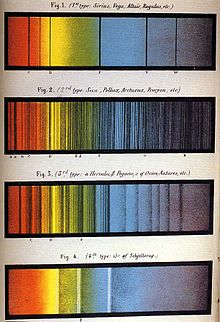Electronic transition

An electronic transition , also known as a quantum leap , is the change in the energy level of an electron in an atom , molecule or ( crystalline ) solid . Such transitions are called electronic , because an electron (in semiconductors , a defect electron can also be meant) changes its energy level.
If a photon is emitted ( de-excitation ) or absorbed ( excitation ) during this transition , the transition is also called an optical or radiant transition. If a photon is absorbed, the system goes into an excited state . The de-excitation transitions can be divided into spontaneous emission and induced emission .
In addition to the radiating transitions, there are also non-radiating transitions, such as the Auger effect or impact ionization . Other quantum mechanical transitions are e.g. B. vibronic transitions in which a molecule changes its oscillation frequency when interacting with a photon and phonon- photon interaction in semiconductors.
probability
In the quantum mechanical description, an atom, molecule or crystalline solid has possible discrete states with different energies ( energy levels ). The state of lowest energy is the basic state .
These states are occupied by electrons in thermodynamic equilibrium :
- in atoms or molecules according to the Boltzmann distribution
- in solids, e.g. B. semiconductors, according to the Fermi distribution .
In general: states of lower energy are more likely to be occupied than states of higher energy. These occupation probabilities influence the transition probabilities of the transitions.
As a first approximation, the transition probabilities are described by Fermi's golden rule . For the simplest model of a system with energy levels, the two-level system , the Einstein coefficients indicate the transition probabilities.
An electron cannot pass from every energy level to any other, because, due to the Pauli principle , two electrons cannot be in the same state . In addition, symmetries can lead to selection rules for the possible transitions or to prohibited transitions . So is z. B. in rotationally symmetrical systems the total angular momentum is a conservation quantity , so that the sum of the angular momentum of an atom (composed of the orbital angular momentum , the spin of the electrons and the nuclear spin ) and the electromagnetic field does not change in a transition . This restricts z. B. in transitions with emission of only one photon, the permitted transitions strongly.
observation
Electronic transitions are observed experimentally, for example in fluorescence or Raman spectroscopy . The light emitted from an excited sample is spectroscoped. The energy difference of the electron before and after a radiating transition is transported away by a photon, which contributes to a resonance line in the fluorescence spectrum. The resonance lines or the underlying electronic transitions are classified and displayed using term schemes or Grotrian diagrams .
The electronic transitions of the hydrogen atom and the hydrogen-like ions are best understood because these are the only particles whose energy levels can be quantum mechanically calculated without approximation.
history
In 1802 the chemist William Hyde Wollaston discovered dark lines in the spectrum of sunlight , which were rediscovered by Joseph von Fraunhofer in 1814 and are called Fraunhofer lines. Gustav Robert Kirchhoff and Robert Wilhelm Bunsen established in 1861 that every chemical element emits characteristic lines and explained the Fraunhofer lines as absorption lines of the elements in the upper layers of the sun. In 1885 Johann Jakob Balmer was able to record part of the spectral lines in hydrogen, which are called the Balmer series , with an empirical formula. This formula was then generalized to the Rydberg formula by Johannes Rydberg in 1888 . Electronic transitions can also be induced by electron impacts, so that in 1913 James Franck and Gustav Hertz explained with their Franck-Hertz experiment that atoms have discrete energy levels.
In 1913 Niels Bohr was able to design Bohr's atomic model , which for the first time allowed discrete energy levels of the electron and explained some observations on hydrogen. Arnold Sommerfeld expanded the Bohr model in 1915/16 and was thus able to explain the fine structure split. At the same time Albert Einstein developed Einstein's rate picture, which for the first time enabled the calculation of transition probabilities in a two-level system. Lise Meitner discovered radiationless electronic transitions in 1922 in connection with X-ray experiments , which Pierre Auger also discovered independently in 1926 and which are now referred to as the Auger effect . In today's semiconductor components such as photodiodes and laser diodes , the targeted selection of certain optical transitions plays a major role; resonators are mainly used for this .
See also
literature
- Wolfgang Demtröder : Atoms, Molecules and Photons: An Introduction to Atomic-, Molecular- and Quantum Physics . Springer, 2010 ( limited preview in Google Book Search).
Individual evidence
- ↑ Joseph Fraunhofer: Determination of the refraction and color dispersal ability of different types of glass, in relation to the perfecting of achromatic telescope . In: Annals of Physics . tape 56 , no. 7 , 1817, pp. 264-313 , doi : 10.1002 / andp.18170560706 .
- ↑ G. Kirchhoff, R. Bunsen: Chemical analysis through spectral observations . In: Annals of Physics and Chemistry . tape 189 , no. 7 , 1861, p. 337-381 , doi : 10.1002 / andp.18611890702 .
- ↑ Hermann Haken, Hans Christoph Wolf: Atomic and Quantum Physics: Introduction to the experimental and theoretical basics . 8th, updated & exp. Edition. Springer, 2004, ISBN 3-540-02621-5 , pp. 116 .
- ↑ Albert Einstein: On the quantum theory of radiation . In: Physikalische Zeitschrift . tape 18 , 1917, pp. 121–128 (first printed in the communications of the Physical Society Zurich).
- ↑ Lise Meitner: About the β-ray spectra and its connection with γ-radiation . In: Journal of Physics A Hadrons and Nuclei . No. 11 , 1922, ISSN 0939-7922 , p. 35-54 , doi : 10.1007 / BF01328399 .
